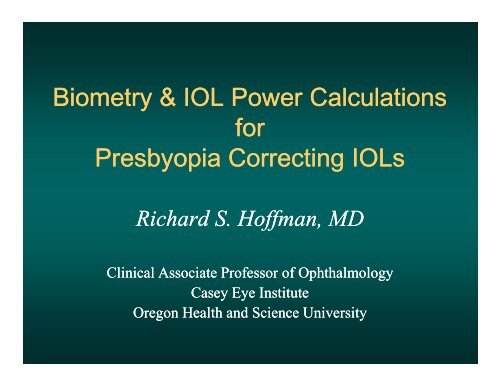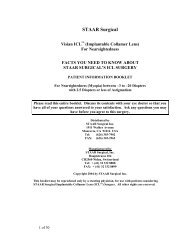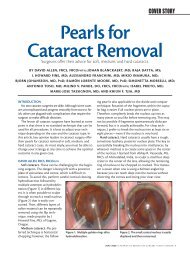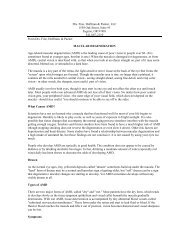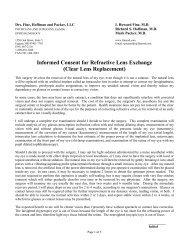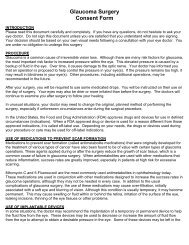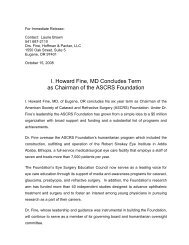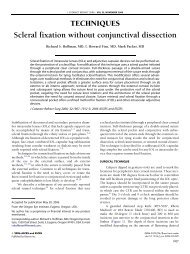Biometry & IOL Power Calculations - Drs. Fine, Hoffman and Packer
Biometry & IOL Power Calculations - Drs. Fine, Hoffman and Packer
Biometry & IOL Power Calculations - Drs. Fine, Hoffman and Packer
You also want an ePaper? Increase the reach of your titles
YUMPU automatically turns print PDFs into web optimized ePapers that Google loves.
<strong>Biometry</strong> & <strong>IOL</strong> <strong>Power</strong> <strong>Calculations</strong><br />
for<br />
Presbyopia Correcting <strong>IOL</strong>s<br />
Richard S. <strong>Hoffman</strong>, MD<br />
Clinical Associate Professor of Ophthalmology<br />
Casey Eye Institute<br />
Oregon Health <strong>and</strong> Science University
Refractive Surgery<br />
• Limitations of LASIK<br />
– High Hyperopes<br />
– High Myopes<br />
– Presbyopes<br />
• Spherical Aberration<br />
– Cornea (stable)<br />
Lens vs. Cornea<br />
– Crystalline lens (increasing + SA)<br />
• Cataract
Accuracy Success<br />
• Patient Selection<br />
• <strong>Biometry</strong><br />
• Lens <strong>Power</strong> Calculation<br />
• Incision Construction<br />
• Preoperative Astigmatism
Axial Length<br />
• Applanation biometry can yield accurate <strong>and</strong><br />
consistent results<br />
• Increasing utilization of non non-contact non non-contact contact techniques<br />
– Zeiss <strong>IOL</strong>Master
<strong>IOL</strong>Master <strong>IOL</strong>Master<br />
Combined <strong>Biometry</strong> Instrument<br />
• Axial length, corneal curvature, <strong>and</strong> anterior<br />
chamber depth<br />
• The axial length measurement is based on an<br />
interference interference-optical optical method termed partial<br />
coherence interferometry<br />
– measurements compatible with acoustic immersion<br />
– accurate to within 30 microns
<strong>IOL</strong>Master <strong>IOL</strong>Master<br />
Limitations<br />
• Optical biometry limited by dense media<br />
– PSC cataract<br />
– Dense NS<br />
– Vitreous hemorrhage<br />
• Lack of lens thickness measurement<br />
(required variable in the Holladay II formula)<br />
Lens thickness can be estimated by the formula:<br />
4.0 + [age/100]
Immersion Ultrasound<br />
• Quantel Axis II<br />
• No limitations of media<br />
density<br />
• <strong>IOL</strong>Master more<br />
accurate for posterior<br />
staphyloma
Immersion Ultrasound<br />
• Immersion <strong>and</strong> partial coherence interferometry<br />
correlated well<br />
<strong>IOL</strong>Master<br />
25.5<br />
25<br />
24.5<br />
24<br />
23.5<br />
23<br />
22.5<br />
22<br />
21.5<br />
Axial Length Measurement<br />
Correlation Coefficient = 0.996<br />
21<br />
21 21.5 22 22.5 23 23.5 24 24.5 25 25.5<br />
• 92% of eyes ± 0.50D with Axis II<br />
Axis II<br />
Correlation<br />
Coefficient = 0.996
Keratometry
Keratometry<br />
Normal Cornea<br />
St<strong>and</strong>ard keratometry <strong>and</strong> CVK are<br />
accurate in measuring four sample points to<br />
determine the steepest <strong>and</strong> flattest<br />
meridians yielding accurate central corneal<br />
power
Keratometry<br />
Following Keratorefractive Surgery<br />
• Sample points are not sufficient to provide an accurate<br />
assessment of corneal refractive power<br />
• Determination Determination of of the the corneal corneal refractive refractive power power from from the<br />
anterior corneal curvature may no longer be valid<br />
– refractive index of the cornea (1.338) may have changed<br />
– especially true when corneal tissue has been removed<br />
(PRK <strong>and</strong> LASIK)<br />
• a change in the relationship between the anterior <strong>and</strong> posterior<br />
curvatures of the cornea
Calculating Corneal <strong>Power</strong><br />
• Methods requiring historical data<br />
– Clinical history<br />
– Modified values from CVK<br />
– Feiz-Mannis<br />
– Corneal bypass<br />
• Methods with unreliable historical data<br />
– Effective RP<br />
– Hard contact lens<br />
– Modified Maloney
Calculating Corneal <strong>Power</strong><br />
Clinical History Method<br />
The change in manifest refraction at the corneal<br />
plane induced by the refractive procedure is<br />
subtracted from the keratometric values prior<br />
to refractive surgery<br />
K = Preop K - ∆ MRx (corneal plane)
Calculating Corneal <strong>Power</strong><br />
Clinical History Method<br />
• Sabotaged by cataract formation<br />
∆ MRx may be confounded by NS<br />
• More useful in RLE
Calculating Corneal <strong>Power</strong><br />
• Simple method<br />
Modified Values From CVK<br />
• Requires the historical surgically induced<br />
refractive change (RC)<br />
• Effective Refractive <strong>Power</strong> (Eff RP)<br />
– Refractive power of the corneal surface within the<br />
central 3 mm pupil zone<br />
– Obtained from Holladay Diagnostic Summary display
Calculating Corneal <strong>Power</strong><br />
Modified Values From CVK<br />
Post Myopia<br />
Adjusted Eff RP = Eff RP – 0.15 (RC) – 0.05<br />
Post Hyperopia<br />
Adjusted Eff RP = Eff RP – 0.16 (RC) – 0.28
Calculating Corneal <strong>Power</strong><br />
Feiz Feiz-Mannis Mannis Method<br />
• <strong>IOL</strong> power is initially calculated as though the<br />
patient had not undergone previous refractive<br />
surgery<br />
• Method unreliable<br />
Final <strong>IOL</strong> = <strong>IOL</strong> + RC/0.7
Calculating <strong>IOL</strong> <strong>Power</strong><br />
• Assume no previous<br />
RS surgery<br />
Corneal Bypass Method<br />
• Target <strong>IOL</strong> for pre LASIK<br />
refractive error (SE)<br />
– Pre LASIK Ks<br />
– Pre LASIK SE<br />
– Post LASIK Axial Length<br />
– Holladay 2
Calculating <strong>IOL</strong> <strong>Power</strong><br />
Corneal Bypass Method<br />
Mean post post-op op refraction = 0.03 D ( ± 0.42 D )
Calculating <strong>IOL</strong> <strong>Power</strong><br />
Corneal Bypass Method
Calculating Corneal <strong>Power</strong><br />
• Effective RP<br />
• Useful Post RK<br />
Unreliable Historical Data<br />
Effective RP <strong>and</strong> Holladay 2 with Double K method<br />
80% ± 0.50 D emmetropia<br />
<strong>Packer</strong> M, Brown LK, <strong>Hoffman</strong> RS, <strong>Fine</strong> IH. Intraocular lens power calculation after incisional <strong>and</strong><br />
thermal keratorefractive surgery. J Cataract Surg 2004; 30:1430-1434
Calculating Corneal <strong>Power</strong><br />
Hard Contact Lens Method<br />
• Calculates the corneal refractive power as a<br />
summation of the contact lens base curve,<br />
power, <strong>and</strong> the difference between the<br />
manifest refraction with <strong>and</strong> without the<br />
contact lens<br />
• Not useful with reduced VA from cataracts<br />
(not be an issue in RLE c<strong>and</strong>idates)<br />
• Reliability questionable
Calculating Corneal <strong>Power</strong><br />
Modified Maloney Method<br />
• Takes into account the difference in anterior<br />
<strong>and</strong> posterior curvature following LASIK<br />
• Corneal <strong>Power</strong> =<br />
( Central Topographic <strong>Power</strong> x 1.11 ) - 6.1
Historical Information<br />
Not Available<br />
Keratometry Following<br />
Keratorefractive Surgery<br />
Post RK Post LASIK / PRK<br />
Effective RP Modified Maloney<br />
Historical Information<br />
Dependable<br />
Clinical History<br />
Modified CVK<br />
Corneal Bypass<br />
Post RK/ LASIK /PRK
<strong>IOL</strong> Calculation Formulas
• 3 rd Generation<br />
– SRK/T<br />
– Hoffer Q<br />
– Holladay 1<br />
• 4 th Generation<br />
– Holladay 2<br />
Formulas
Holladay 2<br />
• Designed to improve determination of the final<br />
effective lens position ELP<br />
– Horizontal corneal white-to white to-white white<br />
– Phakic lens thickness<br />
– Anterior chamber depth<br />
– Axial length<br />
– Age<br />
– Refraction<br />
– Keratometry<br />
• Problematic s/p keratorefractive surgery
ELP s/p Refractive Surgery<br />
• Previous myopic LASIK Hyperopic<br />
• Flatter K (used for <strong>IOL</strong> calculation) will predict<br />
more anterior ELP <strong>and</strong> a lower <strong>IOL</strong> power than<br />
would be used if pre pre-op op K utilized
Holladay 2<br />
Double K Method<br />
• Post-op Post op RS K’s for vergence formula to<br />
determine refractive power of eye<br />
• Pre-op Pre op RS K’s for ELP
Holladay 2<br />
• Improved the accuracy of our <strong>IOL</strong> calculations<br />
• Formula of choice for cataract <strong>and</strong> RLE<br />
• Confirmation<br />
– SRK/T - Long eyes<br />
– Hoffer Q - Short eyes
Final Comments<br />
Attention to detail → Accurate results → Patient Satisfaction<br />
– Patient Selection<br />
– <strong>Biometry</strong><br />
– Lens <strong>Power</strong> Calculation<br />
– Incision Construction<br />
– Preoperative Astigmatism
Thank You


